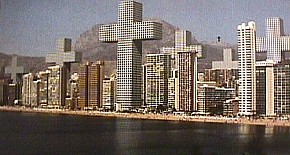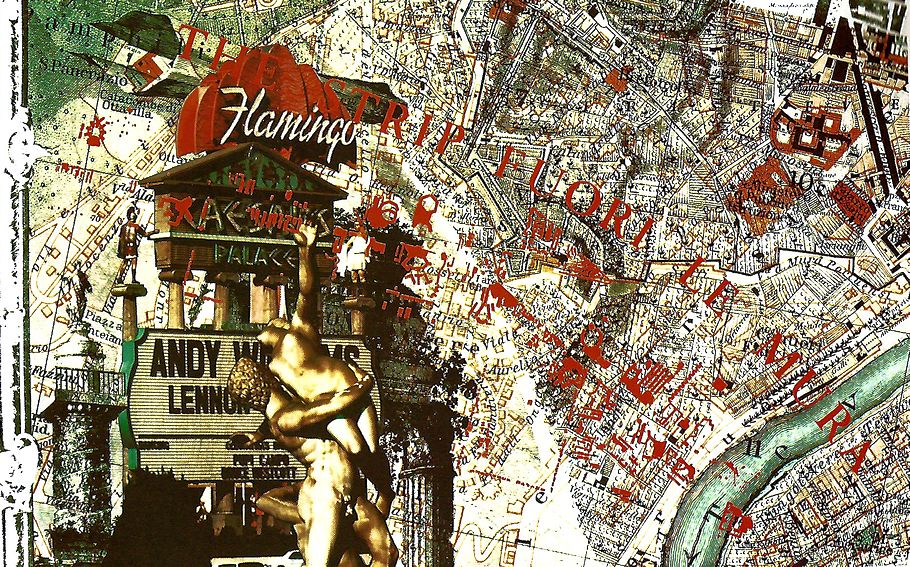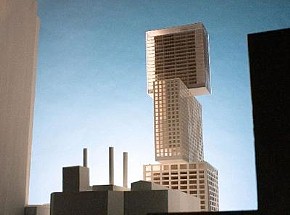And they say, history is no mystery.
OR
When in doubt, blame the butler.
Who knew?!?
Jencks: "Rather than a deep extended attack on modern architecture, showing how its ills relate very closely to the prevailing philosophies of the modern age, I will attempt a caricature, a polemic. The virtue of this genre (as well as its vise) is its license to cut through the large generalities with a certain abandon and enjoyment, overlooking all the exceptions and subtleties of the argument. Caricature is of course not the whole truth. Daumier's drawings didn't really show what nineteenth-century poverty was about, but rather gave a highly selective view of some truths. Let us then romp through the desolation of modern architecture, and the destruction of our cities, like some Martian tourist out on a earthbound excursion, visiting the archaeological sites with a superior disinterest, bemused by the sad but instructive mistakes of a former architectural civilization. After all, since it is fairly dead, we might as well enjoy picking over the corpse."

"Holy Stations of the Cross, Batman!
MVRDV have an interesting way of taking things/concepts to an extreme. Have they maybe learned from "Exodux, or the Voluntary Prisoners of Architecture"? I like their imagination nonetheless. A breed of Dutch sarcasm utilized when most useful?
This sounds to me like solid critique rather than contempt or disgust. And the whole texts reads more of solid architectural (because the text really is so rich with just talking about architecture) critique then some sort of sarcastically based evil plot.
For example:
"Many people like suburia. This is a compelling reason for learning from Levittown. The ultimate irony is that although Modern architecture from the start has claimed a strong social basis for its philosophy, Modern architects have worked to keep formal and social concerns separate rather than together. In dismissing Levittown, Modern architects, who have characteristically promoted the role of the social sciences in architecture, reject whole sets of dominant social patterns because they do not like the architectural consequences of these patterns."
--p. 154, 2nd edition
The overall tone of Part II of Learning from Las Vegas is not one of contempt or disgust.
sarcasm 1 : a keen or bitter taunt : a cutting gibe or rebuke often delivered in a tone of contempt or disgust
| |
It's probably also fair to say that most people that saw Venturi and Rauch's entry at Roma Interrotta saw sarcasm as well. But was "Pop" sensibility too often just confused for sarcasm? Does "Andy W" suggest more Andy Warhol rather than Andy Williams? Does Lennon suggest more John Lennon than the Lennon Sisters?

[Where the Sabine women really raped in front of Caesar's Palace?]
765, you and others may well see sarcasm as an effect of "the ugly and the ordinary" critique, and I concur that that is one fair interpretation, but there is very little sarcasm within the actual text itself.
For sure there is much taunting and ridicule within "the ugly and the ordinary," as there is always taunting and ridicule whenever an orthodoxy is questioned and critiqued, but the task was accomplished without much sarcasm at all.
I did begin to re-read Part II of Learning from Las Vegas last night, and I agree with kablakistan in that sarcasm isn't really the modus operandi. It may be too hard now-a-days to recognize the "Pop" sensibility of the critique--the whole mixture of high art and low art which was then something like sacrilege. Plus, the "in your face" stance (i.e., naming names rather than remaining cautiously abstract) was "just not supposed to be done."
765, you're misrepresenting when you say V, SB and Izenour were "excluded from the High Modernist cocktail party" and therefore bitter. Venturi a Rome Prize recipient, Complexity and Contradiction coming out of MoMA, V and SB teaching at Penn and Yale, Learming from Las Vegas coming out of Yale. I'd say they were definitely guests at the "cocktail" party. The exclusion, you could say, came after Learning from Las Vegas was published (thus no bitterness before the publication, as you imply).
| |

Has Koolhaas (subliminally?) made a whole career out of taunting and bitterness?
Does any sarcastic architecture wound feelings? The Eisenman West Avenue proposal (next to Ground Zero) seems to have that potential.
Perhaps Rossi haunts more than taunts.
The D+S example intrigues me the most. It is indeed taunting and you can almost taste the bitterness. (Not exactly architecture though.)

Is seminal post-modern pastiche also sarcastic? I suppose it did taunt establishment Modernism keenly (and perhaps even somewhat bitterly?). Although one could say establishment Modernism became much more embittered because of it
Is sarcasm more of a dark comedy? (I always thought so.)
|



